download pdf version of PhD book - Universiteit Utrecht
download pdf version of PhD book - Universiteit Utrecht
download pdf version of PhD book - Universiteit Utrecht
Create successful ePaper yourself
Turn your PDF publications into a flip-book with our unique Google optimized e-Paper software.
5.2 Network Generation<br />
. . . . . . . . . . . . . . . . . . . . . . . . . . . . . . . . . . . . . . . . . . . . . . . . . . . . . . . . . . . . . . . . . . . . . . . . . . . . .<br />
to relate it to the radii sizes <strong>of</strong> the two terminating pore bodies, as suggested<br />
by Rao<strong>of</strong> and Hassanizadeh [2010b]. By equating the area <strong>of</strong> the triangle to<br />
the area <strong>of</strong> the equivalent circle we fully specify the triangular cross-section.<br />
Similarly, for rectangular pore-throats, the rectangle area is obtained from the<br />
area <strong>of</strong> the equivalent circle. Knowing the area and the shape factor, we can<br />
calculate the dimensions <strong>of</strong> the rectangle by solving a quadratic equation.<br />
5.2.3 Coordination number distribution in MDPN<br />
One <strong>of</strong> the main features <strong>of</strong> the MDPN is that pore throats can be oriented not<br />
only in the three principal directions, but in 13 different directions, allowing<br />
a maximum coordination number <strong>of</strong> 26, as shown in Figure (2.1). To get a<br />
desired coordination number distribution, we follow an elimination procedure<br />
to rule out some <strong>of</strong> the connections. The elimination procedure is such that a<br />
pre-specified mean coordination number can be obtained. A coordination number<br />
<strong>of</strong> zero means that the pore body is eliminated from the network, so there<br />
is no pore body located at that lattice point. A pore body with a coordination<br />
number <strong>of</strong> one is also eliminated except if it is located at the inlet or outlet<br />
boundaries (so it belongs to the flowing fluid backbone). Thus no dead-end<br />
pores are included in the network. Details <strong>of</strong> network generation can be found<br />
in Chapter 2.<br />
Since in many pore-network modeling studies, a fixed coordination number <strong>of</strong><br />
six is employed, we chose to generate a stochastic network with the coordination<br />
number ranging from zero to 16, but with a mean coordination number<br />
<strong>of</strong> six. However, we shall also present results for networks with other mean<br />
coordination numbers, related to some real porous media. The distribution <strong>of</strong><br />
coordination number and a representative domain <strong>of</strong> the network used in this<br />
study are given in Figure (5.2).<br />
5.2.4 Pore space discretization<br />
Flow in both pore bodies and pore throats arises from pressure gradients. The<br />
conductivity <strong>of</strong> a flow path is dominated by the narrowest constriction along<br />
the path. Under saturated conditions, considering the larger sizes <strong>of</strong> pore bodies<br />
compared to pore throats, one may safely neglect the resistance to the flow<br />
within pore bodies (thus assuming zero pressure gradient within a pore body)<br />
and assign conductances only to the pore throats. This has been the common<br />
practice in almost all pore-network models. However, under unsaturated con-<br />
99

















